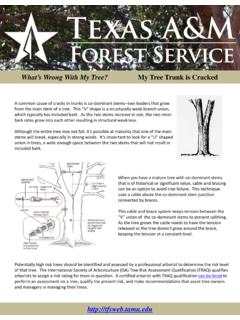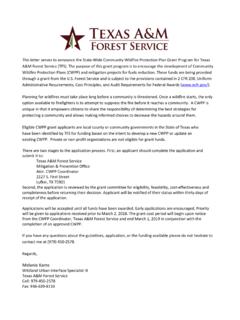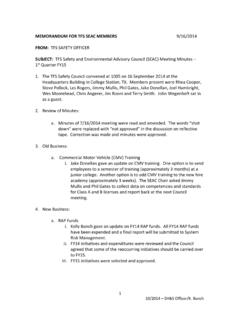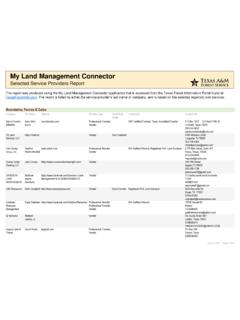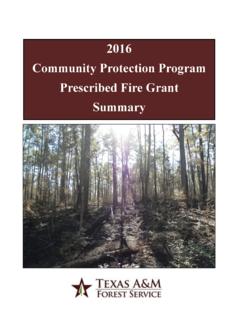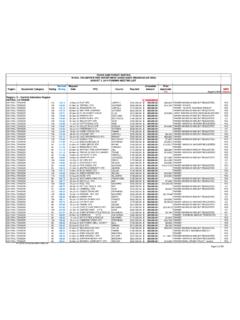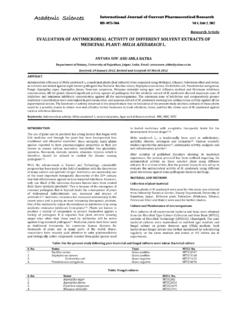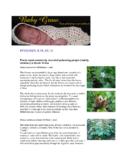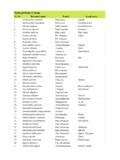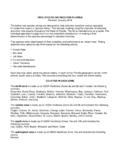Transcription of Forest Health: Timber Management: Common …
1 Timber Management: Guidelines for Selling Page 1 of 2 Forest Health: Common Invasive Plants in South Page 1 of 210. Brazilian Pepper Tree7. Chinese Privet8. Giant Reed9. Johnson Grass4. Japanese Honeysuckle5. Chinaberry Tree6. Chinese Wisteria1. Tree-of-Heaven2. Mimosa3. Camphor TreeForest Health: Common Invasive Plants in South Page 2 of 2 Descriptions of 10 Common Invasive Plants in the South Texas Landscape:1. Tree-of-Heaven: Ailanthus altissima.
2 Originally from China. Rapid growing tree to 80 feet tall with alternate, com-pound leaves, 10-40 leaflets with smooth margins on 1-3 foot stalks. Large terminal clusters of small yellowish-green flowers yield wing-shaped fruit on female trees. Forms thickets and dense Mimosa: Albizia julibrissin. Brought from Asia in 1745 as an ornamental. Deciduous tree with alternate, doubly com-pound leaves and showy, fragrant pink blossoms. Leguminous seedpods persist during winter. Leaves resemble those of Camphor Tree: Cinnamomum camphora. Broad-leaved evergreen that is often twice as wide as it is tall. Grows to 50-100 feet tall. A pungent camphor odor is produced when leaves are crushed.
3 Densely covered with shiny, oval and el-liptical leaves, up to 5 inches long, that are chalky on underside. Young leaves are reddish. In the spring, the tree grows 3 inch spikes of very small yellowish-white flowers, which are soon replaced by black pea-sized berries. Seedlings may be abundant on ground at base of parent Japanese Honeysuckle: Lonicera japonica. Introduced from Japan in the early 1800s for erosion control and as an ornamental. Semi-evergreen, woody vine with simple, opposite leaves. Produces white to yellow (sometimes pink) fragrant flowers from April through Chinaberry Tree: Melia azedarach. Introduced from Asia in the mid-1800s as an ornamental tree.
4 Dark green leaves are doubly compound, alternate, deciduous and display bright yellow fall colors. Fruit is spherical, about inch in diameter, yellow, persists on the tree in winter and is Chinese Wisteria: Wisteria sinensis (or Japanese wisteria W. floribunda). Deciduous, high climbing, leguminous woody vine. Alternate leaves with 7-13 leaflets (Chinese) or 13-19 leaflets (Japanese). Dangling, showy clusters of lavender to white fragrant flowers. Fruit in form of flattened legume pod 3-6 inches long and about 1 inch wide. In-troduced from Asia in Chinese Privet: Ligustrum sinense. Native to China and Europe and brought to the by the mid-1800s as ornamen-tals.
5 Mostly evergreen, thicket-forming shrub having opposite, elliptical leaves with smooth margins. Fragrant, white flowers form in spring and produce clusters of dark purple berries by Giant Reed: Arundo donax. Corn-like stems to 20 feet in height; gray-green, hairless stems with long lanceolate alter-nate leaves that droop at ends. Terminals form dense plumes of flowers to 36 inches Johnson Grass: Sorghum halepense. Tall, coarse, grass with stout rhizomes. Grows in dense clumps or nearly solid stands and can reach 8 feet in height. Leaves are smooth, 6-20 inches long, and have a white midvein. Stems are pink to rusty red near the base. Panicles are large, loosely branched, purplish, and hairy.
6 Spikelets occur in pairs or threes and each has a conspicuous awn. Seeds are reddish-brown and nearly 1/8 inch Brazilain Pepper Tree: Schinus terebinthifolius. Small tree, to 30 feet, with a short trunk usually hidden by dense, intertwining branches. The leaves have a reddish, sometimes winged midrib. Leaves have 3-13 finely toothed leaflets which are 1-2 inches long. Leaves smell of turpentine when crushed. Flowers are white. The fruits are in clusters, glossy, green and juicy at first, becoming bright red. The red skin dries to become a papery shell surrounding the detailed descriptions and more photos, see James H. Miller's publication "Identification of Invasive Plants in Southern Forests.
7 "This plant list is only a recommendation and has no legal effect in the state of Texas. The Texas Department of Agriculture has sole authority to label terrestrial plants as noxious or invasive.
